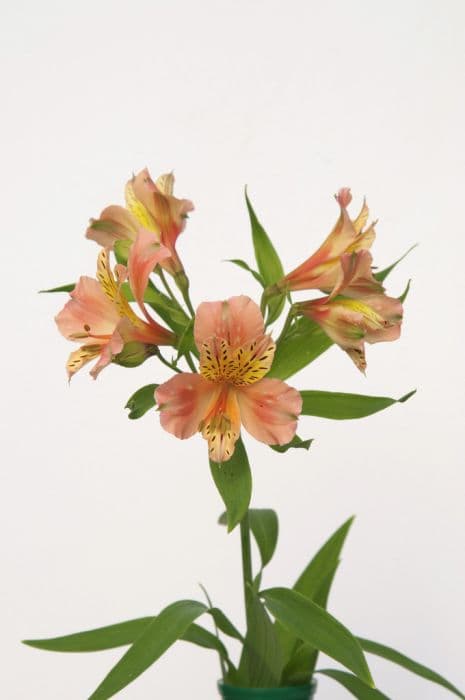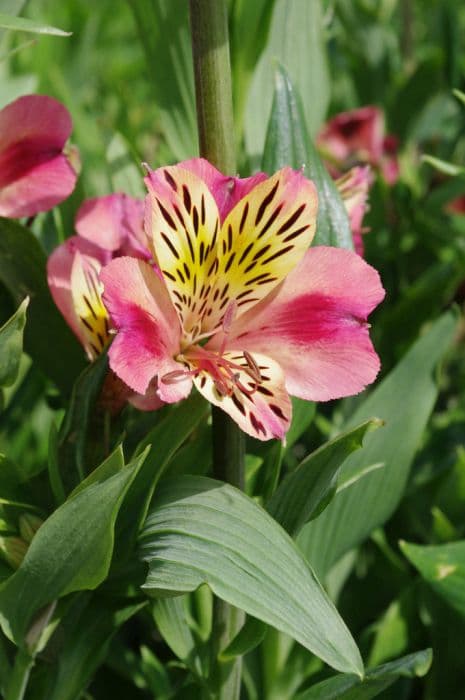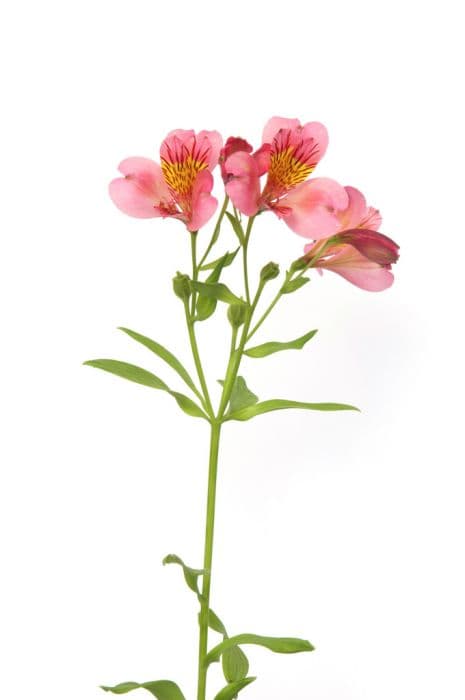Peruvian Lily Alstroemeria Inticancha Sunday = 'Tessunday' (PBR) (Inticancha Series)
![Peruvian lily [Inticancha Sunday]](/_next/image?url=https%3A%2F%2Fplants-admin.emdemapps.com%2Fimages%2Fplants%2F%2Fimages%2F604b646146dd9.png&w=3840&q=75)
ABOUT
The Alstroemeria Inticancha Sunday, belonging to the Inticancha Series, is a visually striking plant known for its beautiful, vivid blooms. The flowers are often a striking combination of colors, featuring shades that can include pink, orange, purple, red, yellow, white or streaks of different hues on each petal, creating an eye-catching display that adds a pop of color to gardens or floral arrangements. These petals sometimes exhibit flecks and streaks, enhancing their ornamental appeal. Their unique shape is reminiscent of miniature lily flowers, which is why they're commonly referred to as Peruvian Lilies or Lily of the Incas. The foliage of the Alstroemeria Inticancha Sunday is lush and green, consisting of slender, lance-shaped leaves that alternate in a spiral pattern up the stems, providing a dense, textured backdrop for the showy flowers. The leaves may also twist so that the bottom side is facing up, a distinctive trait of Alstroemeria. The overall appearance of the plant is bushy and vibrant, with stems that emerge gracefully above the foliage, each stem boasting several buds and flowers, creating clusters of color. This plant is popular for its long-lasting flowers and its ability to bring life and color to gardens and bouquets. Despite its tropical origins, it is versatile and can be grown in a variety of climates, making it a favorite among garden enthusiasts.
About this plant
 Names
NamesFamily
Alstroemeriaceae
Synonyms
Peruvian Lily, Inca Lily, Lily of the Incas
Common names
Alstroemeria Inticancha Sunday = 'Tessunday' (PBR) (Inticancha Series).
 Toxicity
ToxicityTo humans
The Alstroemeria, also known as the Peruvian lily or lily of the Incas, is not significantly toxic to humans. While not generally considered dangerous, if ingested, it can cause mild gastrointestinal irritation, nausea, vomiting, or diarrhea. Handling the plant may sometimes result in skin irritation or dermatitis due to its slight allergenic properties. It is always best to avoid ingesting any unknown plants and to wash hands after handling plants to prevent potential allergic reactions.
To pets
The Alstroemeria, also known as the Peruvian lily, can be toxic to pets if ingested. In cats and dogs, eating parts of the plant may lead to gastrointestinal upset, including symptoms such as vomiting, diarrhea, and abdominal pain. It is advisable to keep the Peruvian lily out of reach of pets to prevent ingestion and to contact a veterinarian if you suspect your pet has eaten any part of the plant.
 Characteristics
CharacteristicsLife cycle
Perennials
Foliage type
Deciduous
Color of leaves
Green
Flower color
Mixed
Height
1-2 feet (30-60 cm)
Spread
1-2 feet (30-60 cm)
Plant type
Herb
Hardiness zones
7
Native area
South America
Benefits
 General Benefits
General Benefits- Long flowering season: Alstroemeria Inticancha Sunday typically blooms from late spring to fall, providing a long season of color.
- Compact growth: Its compact growth habit makes it suitable for container gardening or small garden spaces.
- Attractive flowers: It produces beautiful, showy flowers that come in a range of colors, which can enhance the visual appeal of any garden or floral arrangement.
- Drought tolerance: Once established, the plant is quite drought-tolerant, making it a good choice for water-wise gardens.
- Low maintenance: It requires minimal care once established, needing only occasional watering and fertilization.
- Attracts pollinators: The vibrant flowers attract bees, butterflies, and other pollinators, supporting local ecosystems.
- Versatility: Suitable for borders, pots, and as cut flowers, adding versatility to its uses in landscaping and floral design.
 Medical Properties
Medical PropertiesThis plant is not used for medical purposes.
 Air-purifying Qualities
Air-purifying QualitiesThis plant is not specifically known for air purifying qualities.
 Other Uses
Other Uses- Photography Prop: Alstroemeria flowers are often used in photography for their vibrant colors and intricate textures to enhance the composition of the shots.
- Edible Decoration: The petals of Alstroemeria can be used as colorful, edible decorations for cakes and desserts, though they are not commonly consumed.
- Art Inspiration: Artists may use the stunning Alstroemeria flowers as a subject for painting, drawing, or other forms of visual art.
- Textile Patterns: The intricate patterns and bright colors of Alstroemeria flowers can inspire designs in textiles and fashion.
- Color Dye: The pigments from Alstroemeria flowers could potentially be used to create natural dyes for fabrics or crafts.
- Crafting Pressed Flowers: Alstroemeria flowers can be pressed and used in crafting activities, such as creating personalized greeting cards or bookmarks.
- Floral Water: The petals of Alstroemeria could be steeped in water to create a lightly scented floral water for use in homemade cosmetics or room sprays.
- Educational Tool: These plants can be used in educational settings to teach botany and plant biology, examining the morphology and reproductive cycle of Alstroemeria.
- Literary Symbolism: Alstroemeria can be used as a symbol in literature to represent friendship and devotion due to its commonly associated meanings.
- Biological Research: Alstroemeria, like many plants, can be studied for its genetic traits and adaptation mechanisms, contributing to scientific knowledge in fields such as plant genetics and climate resilience research.
Interesting Facts
 Feng Shui
Feng ShuiThe Peruvian Lily is not used in Feng Shui practice.
 Zodiac Sign Compitability
Zodiac Sign CompitabilityThe Peruvian Lily is not used in astrology practice.
 Plant Symbolism
Plant Symbolism- Devotion and friendship: Alstroemeria, also commonly known as the Peruvian Lily, is often a symbol of enduring friendship and a strong bond between two people, reflecting the commitment to support and stay connected.
- Wealth, prosperity, and fortune: With its abundant and colorful blooms, the Peruvian Lily is sometimes associated with wealth and prosperity, suggesting a wish for good fortune.
- Achieving aspirations: The intricate patterns on the petals of the Peruvian Lily can symbolize the pursuit and achievement of one's personal and professional goals.
- Mutual support: The bouquet of a Peruvian Lily often represents mutual support and the reciprocal nature of a relationship, highlighting a shared journey and mutual reliance.
- Strength and resilience: The sturdy stems and long-lasting flowers of the Peruvian Lily can be seen as a sign of resilience and an ability to endure challenging conditions, much like the bonds of a strong friendship.
 Water
WaterThe Princess Lily should be watered thoroughly, allowing the soil to dry slightly between waterings. Typical watering frequency is about once a week, but this can vary depending on climate, season, and indoor conditions. Ensure that the plant receives approximately one gallon of water during each session, which will provide adequate hydration without causing waterlogged soil. During the hotter months or if the plant is in a particularly sunny position, more frequent watering may be necessary to keep the soil consistently moist, potentially increasing to two times per week.
 Light
LightPrincess Lily thrives in bright, indirect sunlight, making it suitable for east or west-facing windows where it can receive some morning or late afternoon sun. However, it should be protected from the harsh midday sun, which can damage its leaves. A spot that receives dappled sunlight or where sunlight is filtered through curtains would be ideal for this plant.
 Temperature
TemperaturePrincess Lilies prefer temperatures between 65°F and 80°F, which make indoor environments ideal for these plants. They can tolerate a minimum temperature of around 40°F and should be protected from temperatures below that, as cold drafts and frost can be damaging. Maintaining a consistent temperature within this range will help ensure healthy growth and flowering.
 Pruning
PruningPruning Princess Lilies is mostly done to remove spent flowers and dead foliage to encourage further blooming and maintain a tidy appearance. Pinching off the tips of new growth can also promote bushier growth. The best time for pruning is after a flowering cycle when the blooms have faded. Generally, you can prune these plants every few months or as needed to remove dead or damaged plant parts.
 Cleaning
CleaningAs needed
 Soil
SoilThe best soil mix for the Peruvian Lily should be fertile, well-drained, and moisture-retentive. A mix of two parts peat, one part perlite, and one part potting soil would be ideal. The soil pH should range between 6.5 and 7.5 to ensure optimal growth conditions.
 Repotting
RepottingPeruvian Lilies should be repotted every 2-3 years to refresh the soil and accommodate root growth. Repotting is best done in the spring before the onset of vigorous growth.
 Humidity & Misting
Humidity & MistingPeruvian Lilies prefer moderate humidity levels. Aim for a humidity level between 40-60% which can be maintained in typical indoor conditions without the need for special equipment.
 Suitable locations
Suitable locationsIndoor
Place in bright, indirect light and keep at 16-22°C.
Outdoor
Plant in partial shade, shelter from wind, ensure soil drainage.
Hardiness zone
7-10 USDA
 Life cycle
Life cycleThe Alstroemeria, also known as the Peruvian Lily or Lily of the Incas, begins its life cycle as a rhizome, which sprouts to form a seedling. After sprouting, the plant enters a vegetative stage, where leaves and stems develop rapidly, preparing the plant for photosynthesis and growth. As it matures, the Alstroemeria reaches the flowering stage, typically in late spring or early summer, producing vibrant flowers that attract pollinators. The flowers will eventually give way to seed capsules if pollination occurs, completing the reproductive cycle. Once the seeds are dispersed, the plant can enter a dormant period, especially in cooler climates, where the rhizomes survive underground until conditions are optimal for the next growing season. Throughout its life, the Peruvian Lily can be propagated by dividing the rhizomes, thus creating new plants that repeat this life cycle.
 Propogation
PropogationPropogation time
Spring-Summer
The most popular method of propagation for the Alstroemeria, commonly known as Peruvian Lily, is through division of its rhizomes, which is best done in the spring before new growth begins. To propagate, carefully dig up the clump of rhizomes and gently separate them with your hands or a knife, ensuring each division has at least one or two growth points. These divisions should then be planted immediately at the same soil depth they were originally growing, which is typically about 6 to 8 inches (15 to 20 centimeters) deep, allowing ample space for the roots to establish. Water the new divisions thoroughly after planting. This method allows for the clonal expansion of a favored cultivar like the Alstroemeria Inticancha Sunday, ensuring that the new plants will bear the same desirable traits as the parent.




![Peruvian lily [H.R.H. Princess Alice]](/_next/image?url=https%3A%2F%2Fplants-admin.emdemapps.com%2Fimages%2Fplants%2F%2Fimages%2F604b55e81c8b0.png&w=640&q=75)
![Peruvian lily [Indian summer]](/_next/image?url=https%3A%2F%2Fplants-admin.emdemapps.com%2Fimages%2Fplants%2F%2Fimages%2F604b616bc746b.png&w=640&q=75)
![Peruvian lily [Inticancha Creamy Dark Pink]](/_next/image?url=https%3A%2F%2Fplants-admin.emdemapps.com%2Fimages%2Fplants%2F%2Fimages%2F604b5e98bea7c.png&w=640&q=75)
![Peruvian lily [Inticancha Imala]](/_next/image?url=https%3A%2F%2Fplants-admin.emdemapps.com%2Fimages%2Fplants%2F%2Fimages%2F604b619b522ba.png&w=640&q=75)
![Peruvian lily [Inticancha Red]](/_next/image?url=https%3A%2F%2Fplants-admin.emdemapps.com%2Fimages%2Fplants%2F%2Fimages%2F604b5aebac273.png&w=640&q=75)
